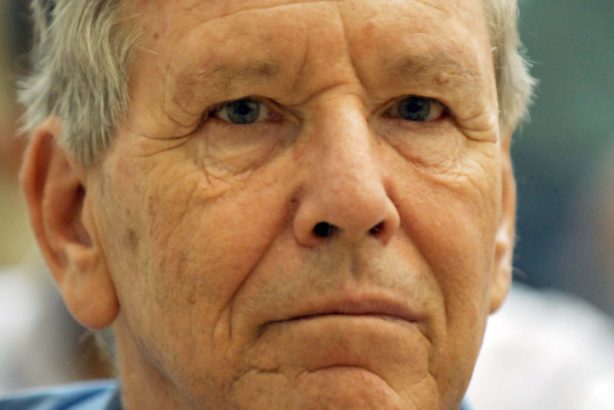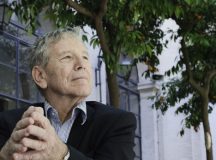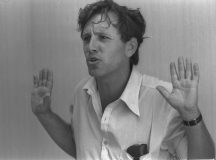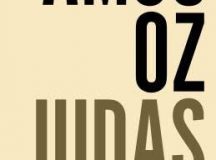While Amos Oz’s novels are often read reductively as political allegories, Liam Hoare suggests that Oz’s special subject is really a particular people, the Israelis, and their experience in a particular place. ‘All the stuff of Israel’ is in his books, writes Hoare, and we should count ourselves fortunate to have such a guide.
Interpreting Amos Oz
It is the fate of the Israeli novelist to be misread. So many, from David Grossman to Nir Baram, write with two pens — one for the novel and another for the essay — and thus there can be, Amos Oz has noted, an unwillingness on the part of readers to draw a line between politics and literature. Many outside Israel ‘tend to read our literature as political allegory,’ he observed in a 1992 speech:
You think you have written a piece of chamber music, a tale of one family but your readers and critics say, ‘Aha! Surely the mother represents the old values; the father is the government; and the daughter must be the symbol of the shattered economy.’
Since the beginning of his career, when he was writing opinion pieces for Davar while working on Where the Jackals Howl (1965) and Elsewhere, Perhaps (1966), Oz has kept two sets of books. His best works of journalism, The Seventh Day (1967, with Avraham Shapira) and In the Land of Israel (1983), still have a marked contemporary resonance. Oz’s relationship with both forms continues unto the present: his last novel, the melodious, crystalline Judas (2014), has been followed by Dear Zealots, a compact collection of three worthy essays on fanaticism, Judaism, and political delusion. They are important contributions to public debate and develop conversations that Oz has been holding his entire life.
Oz’s frustration at being misread or misinterpreted is understandable. Of course, the barrier between the novel and the essay is not watertight. Politics does permeate its way into Oz’s novels in one way or another, but then again, in a highly politicised society like Israel, that much is inevitable. Some of the letters in the epistolary novel Black Box are a microcosm of the larger conversation in mid-1980s Israel between the secular and religious, coastal and hill-dwelling, sides of the society. And in his early short stories, the image of the isolated kibbutz surrounded and hemmed-in by the cries of wild jackals does serve as a metaphor for a community under siege in a changing society.
But to read Oz’s novels only in search of allegory is not only a fool’s errand but also a waste of time. Those who overanalyse novels in this way, Oz rightly complained in the conclusion of his 1996 collection, The Story Begins, would ‘castrate’ the simple pleasure of reading. To read only in order to search for that which is supposedly hidden is to miss that the novel is also a house of pleasure and a world of joyous games. Fima (1991), for example, is rich with descriptive passages so vivid and precise as to make one’s skin crawl — that confirm the suspicion that Fima is the saddest man alive, the eternal schlemiel. In his filthy, tumbledown Jerusalem bachelor pad, ‘a rotting apple was attracting swarms of flies on the windowsill’:
Fima gingerly picked it up between forefinger and thumb, as though it might be contagious, and threw it in the bin under the overfull sink. But the bin was overfull too. The infected apple rolled off the top of the heap and managed to find itself a hiding place among the old canisters and bottles of cleaning fluid. (…) When he prostrated himself and started searching behind the dustbin for the lost apple, he discovered half a roll, a greasy margarine wrapper, and the burned-out light bulb from yesterday’s power cut, which it suddenly dawned on him was probably not burned out after all. Suddenly a cockroach came strolling towards him, looking weary and indifferent. It did not try to escape.
The novelist is, above all, an observer — and Amos Oz is an especially astute one. But especially compelling about his fiction is not just his attention to detail and ritual — what one review of his work called ‘the tiny and extraordinary business of daily life’ — but more broadly the way he writes about human relationships, about love, and how sometimes emotions, in particularly those of expectation and longing, can be frustrated, stifled, and never entirely fulfilled. Beyond the political context, Black Box is about a failed marriage and how even the oldest wounds can be reopened, while Don’t Call It Night (1994) masterfully manages the gradual decline of Theo and Noa’s long-time love affair:
Later, groggy with tiredness, when I’d abandoned my glasses and the light and the book, I could still catch the underwater sound of his bare feet in the passage, no doubt on tiptoe so as not to disturb me, and the fridge opening and the tap running and the lights being systemically switched off, and the apartment being locked up, his stealthy nocturnal wanderings that year after year have made me afraid a stranger has broken in. Some time after midnight I thought I sensed his touch on the door and I was so exhausted that I nearly submitted to his sadness and said yes, but he was already tiptoeing away down the passage — perhaps he had gone out onto the balcony without turning a light on. He likes the balcony on the summer nights. Or perhaps there was nothing, the footsteps, the touch on the door, his wall-piercing sadness, it may all have been mere fog, because I was already asleep.
Set in a small development community in the Negev, Don’t Call It Night is parochial in its scope. Its landscape is the desert, the veil of twilight or glow of the stars upon the distant hills, and its soundtrack a distant recorder and the soft drizzle of the evening rain. The novel’s intertwined B-plot centres around the division that arises in Tel Kadar as Noa, a schoolteacher, seeks to open a drug rehabilitation clinic there. The fate of the centre, and that of Noa’s feelings of isolation and dissatisfaction, becomes tied up with her relationship with Theo, as she begins to withdraw from the world around her. Community, nation, and the individual, body, earth, and soul, are in a sense inseparable.
So it is in many of Oz’s novels. They are neither allegories nor commentaries, but his specialisation, one could call it, in Israel and above all its people — in all its beauty and cruelty — means that his novels are not only a source of tremendous pleasure but also a place of education and information. Oz’s stories are like windows with views out onto another world, and from those books, a great deal about Israel can be learned and surmised. Polemics or political criticism can be read in his essays and much wisdom found within. But the novels present something else: Israel according to its natural qualities and human dimensions. Oz gives us more to see.
Full of the stuff of Israel
It begins with those details: meals consisting of an onion omelette, a ‘geometrical’ salad, black bread served on a wooden board with cheeses and radishes ‘carved in the shape of rosebuds’. There are countless arguments over newspapers and cups of coffee in dusty cafes or kibbutz dining halls. In the background, there are overheard snippets of radio broadcasts: news bulletins about cabinet discussions that ran long into the night, an impending revaluation of the currency, or ministers found out for their corruption. Oz’s novels are full of the stuff of Israel: its sights, sounds, and smells; its habits and distinctions:
In the early hours, the first rain of the season began to fall on the kibbutz houses, its fields and orchards. The fresh smell of damp earth and clean leaves filled the air. The rain rattled along the gutters and washed the dust off the red roofs and tin sheds. At dawn, a gentle mist enveloped the buildings, and the flowers in the gardens sparkled with beads of water. A redundant lawn sprinkler continued its sputtering. A child’s wet red tricycle stood diagonally across a path. From the treetops came the sharp, astonished cries of birds.
In the case of Between Friends (2012), from whence the above passage comes, the kibbutz is Oz’s domain, much as it was in Where the Jackals Howl, Elsewhere, Perhaps, and A Perfect Peace (1982). But he is as much at home in small villages (Scenes from Village Life (2009)), Israel’s cities (Rhyming Life and Death (2007)), and of course Jerusalem, where Fima, Panther in the Basement (1995), Soumchi (1978, which is now back in print), Judas, and The Hill of Evil Counsel (1976) take place. Oz once wrote of Israel’s capital that it was not only the city of his birth but his dreams. From The Hill of Evil Counsel:
From the east, the bells rang out continuously, high bells and deep bells, Russian bells, Anglican bells, Greek bells, Abyssinian, Latin, Armenian bells, as if a plague or a fire were devastating the city. But all the bells were doing was to call the darkness dark. And a light breeze blew from the northwest, perhaps from the sea; it stirs the tops of the pale trees that the City Council had planted up Malachi Street and ruffled the boy’s curly hair. It was evening. An unseen bird gave a strange, persistent cry. Moss sprouted in the cracks in the stone walls. Rust spread over the old iron shutters and veranda railings. Jerusalem stood very quiet in the last of the night.
Beginning with the opening page of Where the Jackals Howl, in which a blast of wind from the sea pierces a dense khamsin that was suffocating the kibbutz, causing it to flee eastward towards the Judean Hills, the importance of landscape to Oz’s fiction is clear. There is, of course, a richness of description, an elegance and felicity in terms of conjuring a sense of place. The moonlight in Don’t Call It Night ‘casts a mask of death on the nearest hills, which are no longer hills but like the notes of a muffled tune. This place seems to him,’ Theo, ‘like the end of the world. He does not mind being at the end of the world. He has done what he can, and from now on he will wait.’
But Don’t Call It Night is one of a number of Oz’s novels that demonstrates, above and beyond its lustre, there is a passionate intensity to the relationship between man and nature in his work. It is as if Theo communes with the landscape: ‘Looking at the hills through the glazed balcony door and across the stone wall at the end of the garden, he feels a sense of gratitude, but for what he is not sure. Could he really be grateful to the hills?’ The desert on this night ‘seems to him and the moonlight justified. In the window opposite, two or three stars glow sharply over the hills. Softly he declares: Now you can breathe.’
In a review of To Know a Woman — a reflective novel about a widowed retired secret service agent — it was noted: ‘The poetic component in Oz’s style comes through vividly when he writes about how nature impinges on his hero.’ For Yoel Ravid, ‘it sometimes happened to him on these autumn nights that the smell of the cold sea infiltrating through the closed windows, the sound of the rain drumming on the roof of the garden shed behind the house, the whispering of the wind in the darkness, kindled with him suddenly a sort of quiet, powerful joy that he had not imagined he was still capable of feeling’.
The same impression of nature upon man goes for Yotam in ‘Deir Ajloun,’ collected in Between Friends, who finds solace among the ruins of an abandoned Arab village on the border of his kibbutz. ‘Yotam sat on the edge of the well and waited, though he didn’t know what he was waiting for or why’:
He leaned over the well, saw only darkness and thought he heard a steady, unbroken murmur, the soft whisper of a distant sea, the sound you hear when you put a seashell to your ear. (…) Thorns and dry leaves stuck to his clothes and he stood up and brushed off his trousers and shirt. Then he began to walk, though what he wanted more than anything was to remain sitting there among the ruins of Deir Ajloun, on the edge of the blocked well, to sit there utterly still, his mind empty of thoughts, and to wait.
A great many of Oz’s novels and stories end this way: on an uncertain, inconclusive note, with his characters waiting for the landscape to respond. If not exactly mystical, nature can certainly be the bearer of omens. ‘The Way of the Wind,’ presented in Where the Jackals Howl, opens upon a gentle dawn that ‘slyly’ conceals what the new day has to offer, as the purple that glowed upon the eastern heights is broken by the sun, ‘and the soft purple yield[s] and fle[es] before the terrible crimson blaze’. The khamsin, in this case, presages disaster.
Happiness doesn’t make good fiction
Zvi Provizor was the kibbutz gardener who, with a small transistor attached to his belt, transmitted a constant stream of disastrous news. The other kibbutz members avoided him. Roni Shindlin called him the Angel of Death and did a ‘marvellous imitation of Zvi’ that made others ‘roar with laughter’. The only person to show him affection was Luna Blank, though in the end their relationship failed to bloom and she left the kibbutz to be with her sister in the US. Her room remained locked after her departure and when Zvi walked past, he thought he could ‘detect the light scent of soap or shampoo drifting from inside the locked room’:
He would wander along the empty paths for a while, rain dripping from the tree branches onto his uncovered head, then go back to his room and listen to darkness, his open eyes blinking, to the final news reports of the day. Early one morning, when everything was still blanketed in wet, frozen darkness, he stopped a dairy-worker on his way to milk the cows and informed him sadly: ‘Did you hear? The King of Norway died last night. Cancer. Of the liver.’
Happiness writes white, as the French essayist Henry de Montherlant once said — or to use the Tolstoyian formulation, while happy families are all alike, every unhappy family is unhappy in its own way. Happiness does not make for interesting fiction and therefore it is only natural that in Oz’s stories, many of his characters exist in differing states of unease or melancholy. Even in a highly collectivised environment like the kibbutz, the characters in Between Friends (including Zvi) are inherently lonely. The residents in Scenes from Village Life are all in search of something, even if they’re not sure what. ‘Men are good in but one way, but bad in many,’ Aristotle wrote. It is not that Israeli society is inherently depressed, but about unhappiness, there is simply more to say.
There is trauma in Oz’s novels — ‘there is no other city in the whole world where so many people dream such terrible dreams every night,’ the narrator of ‘Late Love’ says. In Unto Death (1971), the great trauma was Jewish history, with the nights haunted by memories, lived or inherited, of pogroms and the Holocaust. But as in any society those experiences that fundamentally change the character of a person come in all forms: failed relationships and doomed love affairs; thwarted ambitions or a death in the family. Indeed in Oz’s masterwork, A Tale of Love and Darkness (2002), beyond Israel’s independence, the central episode of Oz’s childhood is the suicide of his mother when he was 12.
In the story ‘Father’ from Between Friends, for example, Moshe Yashar, a boarder at the kibbutz whose mother died when he was seven and father was in a hospital on the road to Tel Aviv, longs ‘once and for all to be one of them’ — a true kibbutznik — ‘and yet he knew very well that it would never happen’. (At the same time, trauma or psychological dislocation does not have to be contained within one person and can be shared with others. In ‘Digging’ from Scenes from Village Life, Pesach Kedem’s claim that he can hear knocking and digging at night from under his house, at first dismissed as nocturnal imaginings, spreads throughout the family.)
There is loneliness, isolation, and alienation — and its shape and form has something to do with one’s environment. ‘One day a man may just pick up and walk out,’ the opening line of A Perfect Peace warns. Yonatan Lifshitz finds himself disinterested in kibbutz life, wondering what on earth he is doing there, and simply longing to be alone. My Michael’s (1968) Hannah Goren, on the other hand, grapples with and drowns in a kind of bipolarity, taken by dark nightmares and lurid, violent fantasies, all against the seemingly banal backdrop of her marriage and the birth of her son in 1950s Jerusalem.
And then there’s Fima — perhaps Oz’s greatest protagonist. His body, with its folds of flesh, sparse black hair, and pimpled chest, is a godawful wreck, as is his dilapidated, dirty apartment, where insects commit suicide in his yoghurts. A receptionist at a gynaecological clinic with delusions of grandeur concerning his political opinions, the genius of Fima is that the narrative forms concentric circles, day upon day, dawn until dusk, all passing by much the same but with the effect that the reader falls deeper and deeper into Fima’s life. At home but not at home in an era of Jewish statehood, Fima’s is a life in search of a meaning:
All these years he had ached to find a place where he could feel at home and he had never managed to, either in his own flat, at the gynaecology clinic, at his friends’, in his city, his country, or his time. Maybe because it was a self-defeating wish from the start. Beyond his reach. Beyond everybody’s reach. …And he said to himself:
‘Right. Exile.’
And he added:
‘So what?’
Shakespeare’s King Richard vainly offered his kingdom for a horse. Whereas Efraim Nisan, close to three in the morning, was ready to exchange the whole of his legacy for one day, one hour of total inner freedom and of feeling at home.
The 70th anniversary of Israel’s independence had proved an opportunity to revisit the country’s folklore: its myths, its heroes, and even its villains. But as compelling and fascinating as they are, Israel is often far more interesting and complex than the fables and sagas it tells itself. In its ostensibly humble stories, including those of Amos Oz, there exists not only a great deal of beauty and loveliness, exquisite literary pleasure, but a kind of higher truth that is the product of acute observation, a heightened sense of perception, and perhaps more importantly of all, a tremendous love of subject. Pieced together, Oz’s novels form a literary map of Israel, marking both the land and its people, pointing the way for the rest of us, and we should count ourselves fortunate to have such an eminent and compassionate guide.






































This beautifully poignant analysis of Amos Oz’s work must be cherished. A fitting tribute to a wonderful writer.